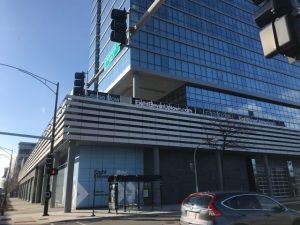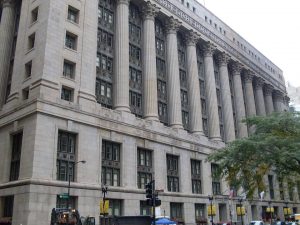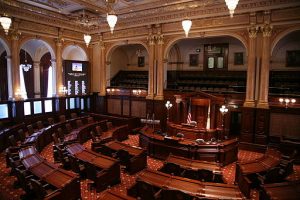Like so many Chicago neighborhoods, Pilsen has been the subject of heated debate over the loaded word and process of gentrification. Community-based groups like the Pilsen Alliance have fought against increased development while local developers, including John Podmajersky III and the University of Illinois at Chicago (UIC), continue to attract higher-income residents to the area.
An Eastern European neighborhood since the 1800s and a predominately Mexican area since the 1960s, Pilsen has been a port of entry for immigrants for most of its history. But the area’s new development is bringing more expensive realty to this near South Side hub of culture for the first time. Several factors, including tax increment financing (TIF) districts, the demise of some nearby Chicago industry, and the rise of the “Chicago Arts District” in east Pilsen, are also contributing to the area’s growth.
“There’s a unique character to Pilsen,” said Ryan Kelsey, director of resource development at the Resurrection Project, a nonprofit organization that provides affordable housing and resources to residents in Pilsen, Little Village and the Back of the Yards neighborhoods.
Kelsey said Pilsen is a popular choice among college students even if they are not from Chicago, particularly because of its unique personality.
“I think we only see maybe three franchise restaurants in all of Pilsen,” said Kelsey. “Everything else is pretty much a mom and pop family offering. It really gives you a sense of, ‘Wow, this is a neighborhood with character.’ And it is only three El stops from the Loop.”
According to Nacho Gonzalez, assistant director of UIC’s Neighborhoods Initiative, proximity to the Loop is a big factor in which neighborhoods become gentrified.
Other major factors include zoning laws, aldermen’s actions, property taxes and the use of old industrial spaces – as old factories are often turned into upscale residential lofts. In Pilsen, another major factor is UIC’s expansion.
Gonzalez said that Pilsen became predominately Mexican after UIC built its campus around Roosevelt Road and Halsted Street, a previously Mexican neighborhood, in the 1960s. Italian neighborhoods were also displaced by UIC. More recently, UIC expanded even farther south to 16th and Halsted streets.
“It brought a lot of people to the area,” said Frank Cappocia, the owner of Pilsen Realty, about the UIC south campus expansion. “It also gave the area residents something to do. There’s places to eat over there now, places to go. It’s not neglected any more as it was. It’s affected the area quite a bit.”
Pilsen is also one of Chicago’s most active art hubs. The neighborhood is home to the nation’s largest Latino arts institution, the National Museum of Mexican Art, according to the museum’s Web site. The neighborhood is peppered with small independent art galleries, and on Halsted Street just south of UIC’s campus sits the Chicago Arts District.
The art development on Halsted Street was created by the Podmajersky family, a third-generation Pilsen family that began to develop East Pilsen as an area for artists to live and work in the early 1960s, according to the Chicago Arts District’s Web site. The area is now home to “art walks” the second Friday of each month.
“Mr. Podmajersky took a bet. He really invested in [East Pilsen] when a lot of people thought it was just going to crumble,” said Kelsey. He said Podmajersky began cultivating the neighborhood during the expansion of the Dan Ryan Expressway that runs right over East Pilsen.
“[Podmajersky] wanted to develop this into the art district, like the SoHo of Chicago,” said Kelsey. “I don’t think it’s a bad thing. I think the important thing is that there’s an opportunity for a balance and a mix there, because people that are in the arts district will come into neighborhoods like this and will go to the local businesses.”
Kelsey argues that gentrification is not as black and white as some characterize it.
“It’s very easy to polarize the gentrification issue; it’s a good issue, it’s a bad issue,” he said. “In the long run, property values have to increase. If property values don’t increase, the neighborhood starts to fall into decay.”
The key to healthy development, advocates say, is using policies and subsidies to help existing residents stay in their homes even as property values — and, along with them, property taxes — rise. For example, the Resurrection Project works to provide affordable housing for Pilsen residents with buildings like the recently completed Casa Morelos, which features affordable housing at a variety of income ranges as well as market rate housing.
Maria Torres, a community organizer for the Pilsen Alliance community group, which has organized against gentrification in the past, said that development can hurt residents who can’t afford to pay higher property taxes.
“Once they do development it starts raising the value of homes, it starts raising property taxes,” she said. “It’s making your home worth more, but you’re pushing out those folks that were there before, because their income level is staying the same.”
Torres also said that TIF funding plays a major role in Pilsen’s gentrification. As condominiums are built, she said, property taxes rise. New condominiums generate additional property tax for the TIF, which are often then reinvested in bringing more development to the area.
“Instead of [property tax money] going back to the schools, libraries and parks, it goes into a special account (the TIF),” she said. “And they use that money to lend to developers. There’s no accountability.”
Abigail Carbajal, a Pilsen resident for 35 years, said she’s seen property taxes rise dramatically.
“It’s affected us a lot,” said Carbajal. “The taxes have gone up a lot. Many of the people I know [have left].” Carbajal also said that violence has decreased since the neighborhood began to develop.
Chicago’s industrial past also plays a large role in gentrification, especially for once industrial neighborhoods like Pilsen, according to Gonzalez.
“What Chicago is stuck in is that it lost all its manufacturing,” said Gonzalez. “So it’s got to raise property taxes in order to keep the streets paved and pick up garbage. The easy way out is just to abandon the factories and make lofts, so it’s a constant fight between the developers and the manufacturing districts.”
Gonzalez said that Pilsen is at higher risk for gentrification because developers may be able to make huge condominium complexes out of abandoned factories, thus changing the face of the neighborhood much faster than single house-by-house gentrification.
“I’ve interviewed factory owners, and when developers want to come in and take over their factory, they start harassing them,” said Gonzalez. Gonzalez charged that developers pay off city officials to persuade them to harass building owners whose property they want to buy, including with fines for often minor building violations.
“So it [becomes] easier for them to just sell and move out to the suburbs,” Gonzalez said.
Changes in zoning laws to allow residential development in a previously industrial zone may be introduced by an alderman. However, to get a zoning amendment passed, it must be approved by the mayor, the city council and the Chicago Committee on Zoning, according to Nicole Welhausen, a legislative aide to the committee.
“What’s nasty about gentrification is that it displaces people,” said Gonzalez. “But gentrification is really a complex thing. There are different angles to look at it from, and many times when people study gentrification they just look at one angle.”
Related articles by Zemanta
- Pilsen Craft Fair And Dance Party (chicagoist.com)
- Pilsen Murals: A Need To Change The World (chicagoist.com)







Be First to Comment